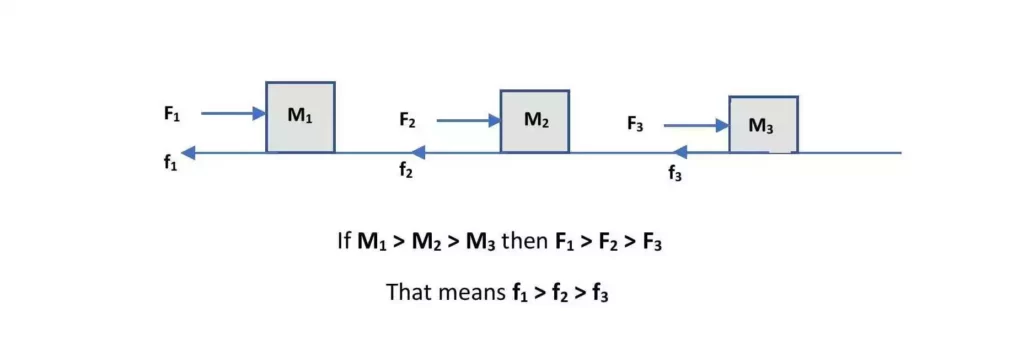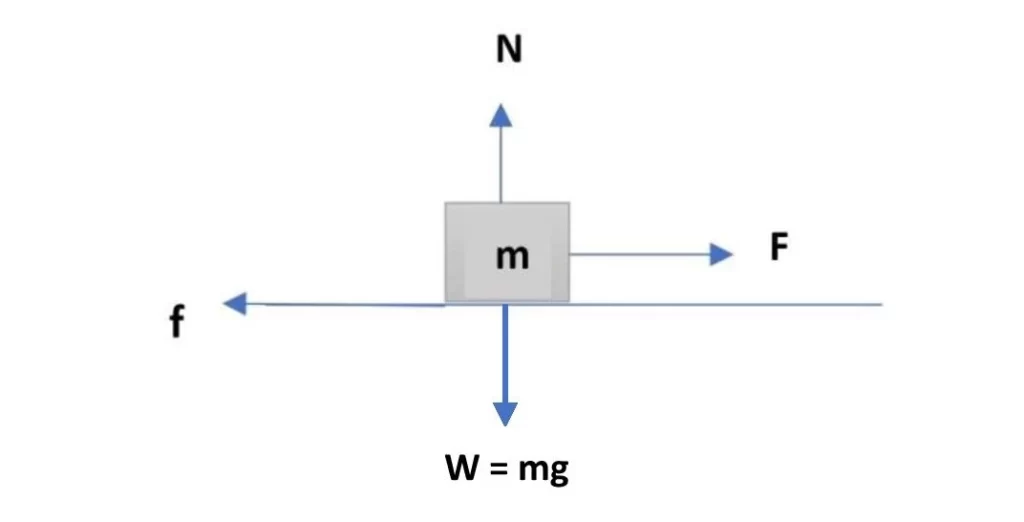The acceleration of a moving object depends on the net force acting on it. Therefore, the net force is an important quantity to study the dynamics of an object. In another article, we discussed equations for different types of Forces. In this article, I’m going to explore the Force of Friction in detail – its definition, formula, units and all related facts.
Contents of this article:
- What is Frictional Force?
- Examples of force of friction
- The formula of Friction force
- Units of force of friction
- On what parameters does the force of friction depend?
- How to calculate force with friction?
What is the Friction Force?
When two surfaces are in contact with each other and one moves or tries to move with respect to another, a resisting force arises that opposes the relative motion between the surfaces. This resisting force is called the Friction force. The main function of the frictional force is to oppose the relative velocity between the contact surfaces.
Examples of friction force
Friction is almost everywhere. Here is a list of examples of friction force –
- If you pull or push a block on a rough floor, a frictional force acts between the floor and the contact surface of the block.
- If you rub two substances, friction force acts there and generates heat. Heat generates if you rub your palms.
- Cheetahs cannot run for a long time because of the heating of toes due to friction with the ground.
- We can walk due to the friction between the road and our toes.
- We can drive vehicles due to the friction between the road and the wheels of vehicles.
The formula for Friction force in Physics

Now we need a mathematical equation of Friction force to measure it. To understand the basic formula of frictional force, we need to realize the concept.
Suppose you are asked to push three blocks of different masses on a rough floor on three different occasions. You will feel greater difficulty to move the block of the greater mass. While pushing a block you are actually trying to overcome the static friction between the floor and the contact surface of the block. That means the frictional force between the floor and the contact surface is greater for a heavy body.
Hence, \small{\color{Blue}friction (f)\propto mass (m) }. But, this does not make the friction force different from an externally applied force because in either case force is proportional to mass.
It is seen that the friction force between the same two surfaces changes when they are inclined. Again, the normal reaction is proportional to the mass of the object and changes with the angle of incline of the surface. That means friction does not depend on mass directly, it depends on the normal reaction which is dependent on mass and inclined angle.
The Friction Force (f) is proportional to the Normal reaction (N) of the surface.
Mathematically, {\color{Blue}f\propto N }
or, {\color{Blue}f=\mu N }……………(1)
Where {\color{Blue}\mu } is the coefficient of friction between the contact planes.
Equation-(1) is the fundamental formula for the force of friction.
Units of Friction Force
Since Friction is ultimately a force, its units are the same as that of other forces. Hence the SI unit of the friction force is Newton (N) and its CGS unit is dyne. Its dimensional formula is also the same as the applied force i.e. [MLT – 2].
On what factors does the friction force depend?
The following four factors affect the friction force –
- The roughness of the surface: Greater roughness offers greater friction.
- Mass of the object: Heavy objects feel greater friction
- Relative velocity of the surfaces: Friction decreases as the relative velocity between the surfaces increases.
- Angle of incline: The normal reaction and thereby the friction force changes with a change in the angle of the incline of the surface.
How to calculate friction force?
To find the acceleration of an object on a rough plane we need to calculate the net force i.e. the force with friction. Therefore the calculation of friction force is very important here.
If you know the frictional coefficient of the surface then use these three steps to calculate frictional force –
- Step-1: Draw a free-body diagram.
- Step-2: Find the normal reaction of the object from the free-body diagram.
- Step-3: Use equation-(1) to find the force of friction.
Let’s explain this with an example.
Problem:
A force of 20 N is applied on a block of mass 5 kg which is placed on a rough surface having the coefficient of friction 0.2. Find the friction force on the block. Also, find the net force with friction and the acceleration of the block on that surface.
Answer:

The applied force, F = 20 N, Mass of the block, m = 5 kg, Coefficient of friction, \mu = 0.2.
Since the angle of incline is not mentioned here, we will consider that the surface is horizontal. Then the normal reaction, N = mg
or, N = 5 × 9.8 = 49 Newtons.
i) The friction force on the block is, f = \mu N
or, f = 0.2 × 49
or, f = 9.8 Newtons……..(Answer)
ii) The net force on the block is, Fnet = (F – f)
or, Fnet = (20 – 9.8)
or, Fnet = 10.2 Newtons…………..(Answer)
Now, using the equation of Newton’s second law of motion, the acceleration of the block, \color{Blue}a = \frac{F_{net}}{m}
or, \color{Blue}a = \frac{10.2}{5}
or, acceleration, a = 2.04 m/s-2 ………….(Answer)
Summary
Here is the summary of the properties of friction force –
- Friction force arises when contact surfaces move or try to move relatively.
- It opposes the relative motion between the contact surfaces.
- The frictional force depends on the roughness of the surface, the mass and relative velocity of the object and the incline of the surface. But it does not depend on the area of the contact surfaces.
- We can walk, ride vehicles, can do work, etc. with the help of friction. These will not be possible without friction.
- The only and significant demerit of friction is that it reduces the net effort (external force). We need to find the net force with friction.
This is all from this article on the formula for friction force in physics and its examples.
Thank you!
Related articles:
- Types of Friction – Static, Kinetic and rotational
- Equations of force in Physics
- Contact Forces – definitions and examples